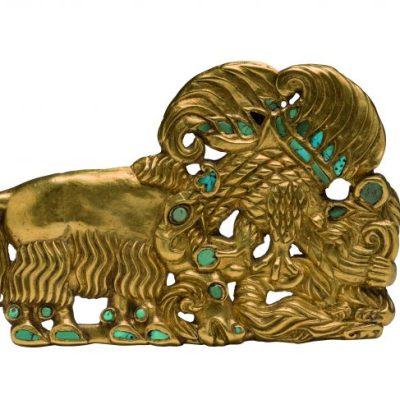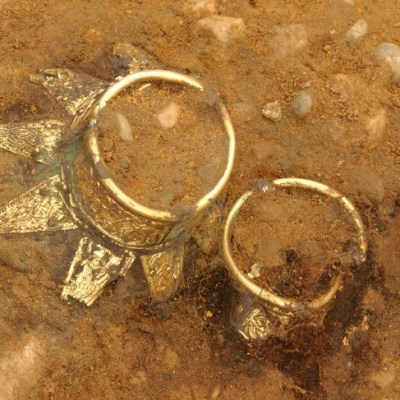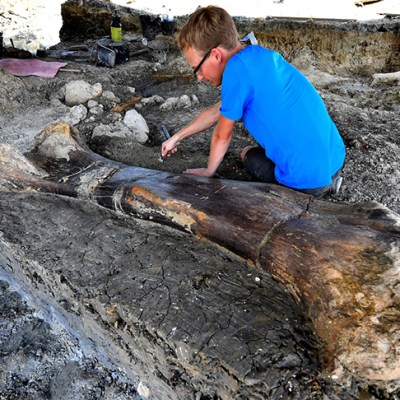From the January 2022 issue of Apollo. Preview and subscribe here.
It’s around 5.15am in East Kazakhstan and the sun has barely risen over a vast, grassy plain; the mountains that ring this valley are dark silhouettes against a pink sky. There might be a figure on horseback in the distance, but it’s hard to make out from here. Dark, too – but all the more visible for that – are strange masses pushing up through the flat ground, like giant whales breaking the surface of an ocean. These are kurgans, or burial mounds, built by the Saka people between 900 and 200 BC. There are more than 300 of them in this high valley, which is called Eleke Sazy.
‘The Saka had such a sense of drama and place,’ says archaeologist Rebecca Roberts, curator of the exhibition ‘Gold of the Great Steppe’ at the Fitzwilliam Museum in Cambridge. We are standing in front of two blown-up photographs of that vast sunrise landscape in East Kazakhstan. ‘All of their cemeteries are in these incredibly beautiful locations,’ Roberts adds. It was at Eleke Sazy in 2018 that Kazakhstani archaeologists made an exceptional find in one of the burial mounds: the grave of a young Saka archer, clearly a member of the elite and no more than 18 years old when he died. He was buried with his bow and arrows and dagger, and much of the gold of the exhibition’s title is his: around his neck a weighty, spiral-shaped torque; from under his right hand a bronze dagger’s ornate gold scabbard, with stylised deer and other animals picked out in gold granules, reflecting what Roberts calls ‘a predator-prey dynamic that you see time and time again’ in Saka art. Among these outlines are inlaid semi-precious stones, shaped and positioned to suggest eye, ear, muzzle; a gorytos, or bow-and-quiver case, with gold overlay whose granular decoration and inlays of turquoise, lapis lazuli and other stones again outline another pair of deer, their hooves tucked under themselves, their joints beautifully picked out in spirals; eight deer-shaped plaques, one of them larger and crowned with splendid antlers, his musculature expressed by incisions and impressions in the metal.
Overlay of the wooden base of a gorytos, 8th–6th century BC, Eleke Sazy burial complex, Kazakhstan

These particular items of gold are only here for us to see because the archer’s grave had been protected at some point in time by a fall of stones inside the burial chamber, cutting it off from would-be looters. A female teenage relative buried in the same kurgan – probably his sister – was not so fortunate. Her resting place was plundered and her bones scattered, leaving little more than a small weaving tablet (archaeological gold all the same). Looting has always been a problem – even, in some cases, soon after the burials were made – and makes urgent the work to uncover, record and protect this heritage; the last time a Saka burial was discovered intact in Kazakhstan was in 1969, Roberts tells me.
Gold sheath for a dagger with turquoise and lapis lazuli inlay, 8th–6th century BC, Eleke Sazy burial complex, Kazakhstan

But who exactly were the Saka? There are glimpses of them – as foreigners – in ancient texts and sculpture. In his Histories Herodotus identifies the groups occupying the region north of the Black Sea as ‘Scythians’, and then: ‘Above them dwelt the Arimaspi, men with one eye. Still further the gold-guarding Griffins.’ A stone relief from Persepolis, carved in the 6th century BC, shows a delegation of Tigrakhauda Saka, or ‘Saka with pointed hats’, bringing gifts to the Persian king Darius I (who defeated a Saka king in 519 BC).
As a genetic study published last year has confirmed, the Saka people were one of the earliest Scythian groups in existence. In these rooms at the Fitzwilliam they speak for themselves, fleshing out those distant, ancient outlines. Here are goldsmiths who, exploiting the abundance of gold deposits in their region, express their intimacy with the animal world through myriad shimmering forms hammered, moulded or cast: dove-like birds, their heads gracefully reaching back to preen an unfurled wing, with crescents or tear shapes cut out of the flattened metal to suggest feathers; elks that seem to be resting on grass, or flowers – or is it cloud, signifying their lofty position up in the Altai mountains? There’s room in this golden carnival of animals for mythical beasts, too: hook-beaked griffins, and strange, shape-shifting creatures that could be chimeras.
Figure of an argali on four-leaf clover, c. 6th–5th century BC, Eleke Sazy burial complex, Kazakhstan

Here are great horse tamers, who value their steeds so highly they dress them as richly as their human elites, and are buried with them. A people who know how to fight with sword, and bow and arrow, just as they know how to make richly ornamented clothes from fur, felt and leather. A gold hairpin in the shape of an opium poppy – and containing the remains of what might be an actual poppy head – points to a people with long-distance trade networks, and an appetite for the ‘exotic’.
Hair or headdress ornament, c. 4th–3rd century BC, Eleke Sazy burial complex, Kazakhstan
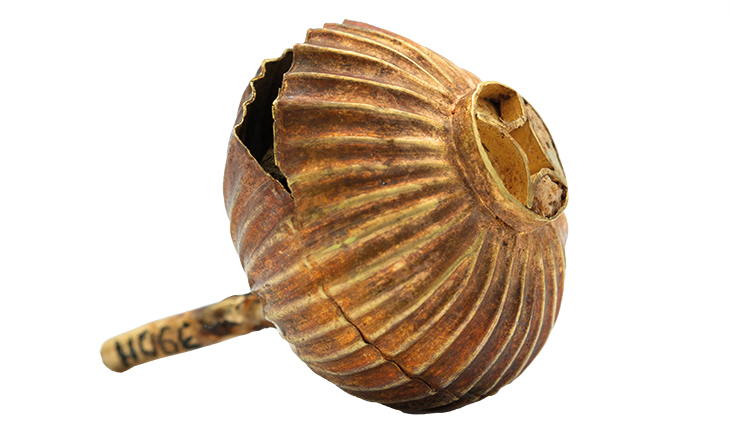
But don’t get too comfortable with us, they seem to say. High-ranking Saka may have been buried with their horses, but that of course meant the animals had to be sacrificed. Meanwhile, ancient-protein analysis has revealed that although much of the fine leather such as that used for the bindings on arrow shafts was goatskin, occasionally the material was made from human skin.
To scramble the aphorism, there’s gold beyond all that glitters here, too. Roberts has dedicated a vitrine to a seemingly unexciting item from the archer burial: a bronze belt fitting with interlocking ring joint. ‘I wanted to have it out because it’s a beautiful piece of bronzework, still fully functional 2,700 years after it was made. But also it tells you about the importance of horses, because one end attaches to a belt and the other end to a weapon, so when you’re riding it absorbs the movement and doesn’t whack against your leg; it’s such a tiny piece yet gives us this massive story about horses, as well as the Sakas’ technological skill in creating these pieces.’
The skill and care with which these things were made is echoed, more than two millennia later, in the precision with which they have been excavated, cleaned and recorded. Roberts points to a piece of turquoise from the archer burial, so tiny it might have been lost several times over. ‘I’ve seen a photograph of every single artefact in the ground, exactly where it was found, which for this kind of Scythian-Saka gold is exceptional because so much of it has been looted in the past, particularly in the 18th and 19th centuries, when there was a big Russian imperialist push to collect this wonderful gold and bring it back to St Petersburg. So you’ll see this type of material in museums but it doesn’t have context, and only a vague regional provenance.’
Last year was the 30th anniversary of Kazakhstan’s independence, and it seems fitting that this exhibition coincided with that milestone. Beyond the fact that excavations and research have been Kazakhstani-led (each exhibit here is accompanied by the name of the individual archaeologist who excavated it), life-size reconstructions of Saka figures in all their finery – including, in the case of the archer, 40,000 gold beads decorating shoes and trousers – have been meticulously created by Kazakhstani archaeologists, conservators and artisans. The project has argued for the value of drawing comparisons between these ancient archaeological finds and more recent Kazakh materials, practices and artefacts. We may never discern the individual hands who fashioned these fascinating objects but, millennia later, the hands that have brought them to light with such reverence are rightly being celebrated.
Two gold headdress plaques in the form of birds, c. 4th–3rd century BC, Eleke Sazy burial complex, Kazakhstan
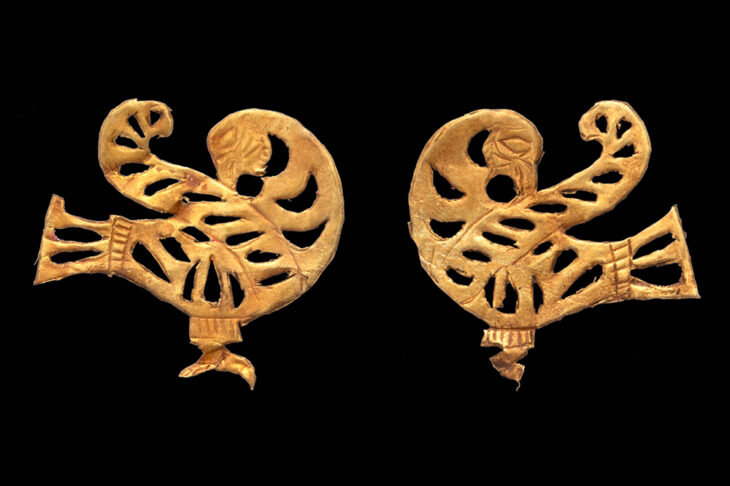
‘Gold of the Great Steppe’ is at the Fitzwilliam Museum, Cambridge, until 30 January.
From the January 2022 issue of Apollo. Preview and subscribe here.
